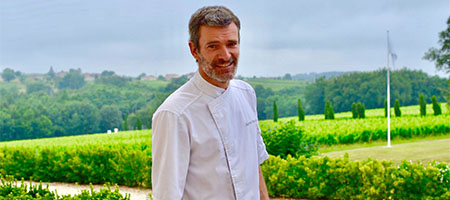France has been on lockdown for a month and a half now. How are you making use of your time in quarantine?
I’m fine-tuning my kitchen garden, because I’d like to open an environmentally responsible restaurant in Saint-Morillon, to the south of Bordeaux. The goal is to source 100% of the fruits and vegetables from this garden. I’m starting off with a completely vacant hectare of land. I already had the plans for the layout of the garden in place, but I have used my time in isolation to take an online course in permaculture. As the works at the restaurant have obviously been delayed due to the crisis, I’m putting together an association of small farmers to sell my vegetables. I’m also hoping to launch a mobile bread truck. The lockdown is also an opportunity to reinvent oneself.
We hear a lot about permaculture nowadays. Can you explain to us briefly how it works?
Permaculture is a cultivation technique which works in alignment with the fundamental principles of nature. For example, we know that nature abhors a vacuum. All my plants are sown in straw beds, which help reduce weeds, improve soil exchange capacity, attract beneficial insects and create a favourable ecosystem. As for the plants themselves, I’ve taken inspiration from forests, which grow in layers: the trees at the top, shrubs and ferns below, and mushrooms right at the bottom. In our kitchen garden, heads of lettuce will grow under tomatoes, red berries will push under kiwi plants and vines, all under the shadow of fruit trees… In all, 300 kinds of fruits and vegetables are currently growing or being planted.
What does cooking mean to you?
I became a chef because I discovered my love for cooking after a first stint as an air-traffic controller. I chose this profession because I love working with and transforming ingredients, and because I love bringing joy to people through food. One could say that I’m specialized in plant-based cuisines… and that I strive for balance. I’m not a fan of busy, complex dishes. I prefer paring down my food both in terms of quality and quantity so that my guests get just the right amount of energy.
What does Malromé evoke for you?
In one word, “elegance”. Château Malromé is a hidden gem such as one wouldn’t expect to find in this part of Gironde. Unlike Saint-Emilion, Saint-André-du-Bois is not a famous or hip destination. But Malromé is worth the detour. The Château is gorgeous, with a rich historic wing that really gives us a glimpse of the world of Henri de Toulouse-Lautrec. The restaurant is very pleasant and the contemporary art museum features stellar artists. My favourite among the wines produced on the estate is the 2018 Château Malromé Toulouse-Lautrec AOC Bordeaux Blanc. Mildly acidic and with a hint of sweetness, it’s an extremely balanced and refreshing white wine!
While we wait for the Adèle restaurant to open, what recipes would you recommend to pair with the wines from the estate?
The Château Malromé Toulouse-Lautrec red goes well with grilled meat, while the Esprit de Malromé red is just perfect to serve with beef slow cooked in a sauce. I had once made a wine-based stew using a piece of meat marinated in a mixture of miso, coriander and lemongrass for a touch of freshness. I would recommend a marinated salmon dish cooked on a barbecue to accompany the whites. You could, for instance, marinate the fish for about 20 minutes in a mixture of lime, soya sauce, coriander, smoked paprika, red onion and a little bit of coarse salt and brown sugar. Throw on some pre-cooked asparagus on the barbecue for a smoked vegetable accompaniment, and you have a winner!
Malromé wine on the eshop



